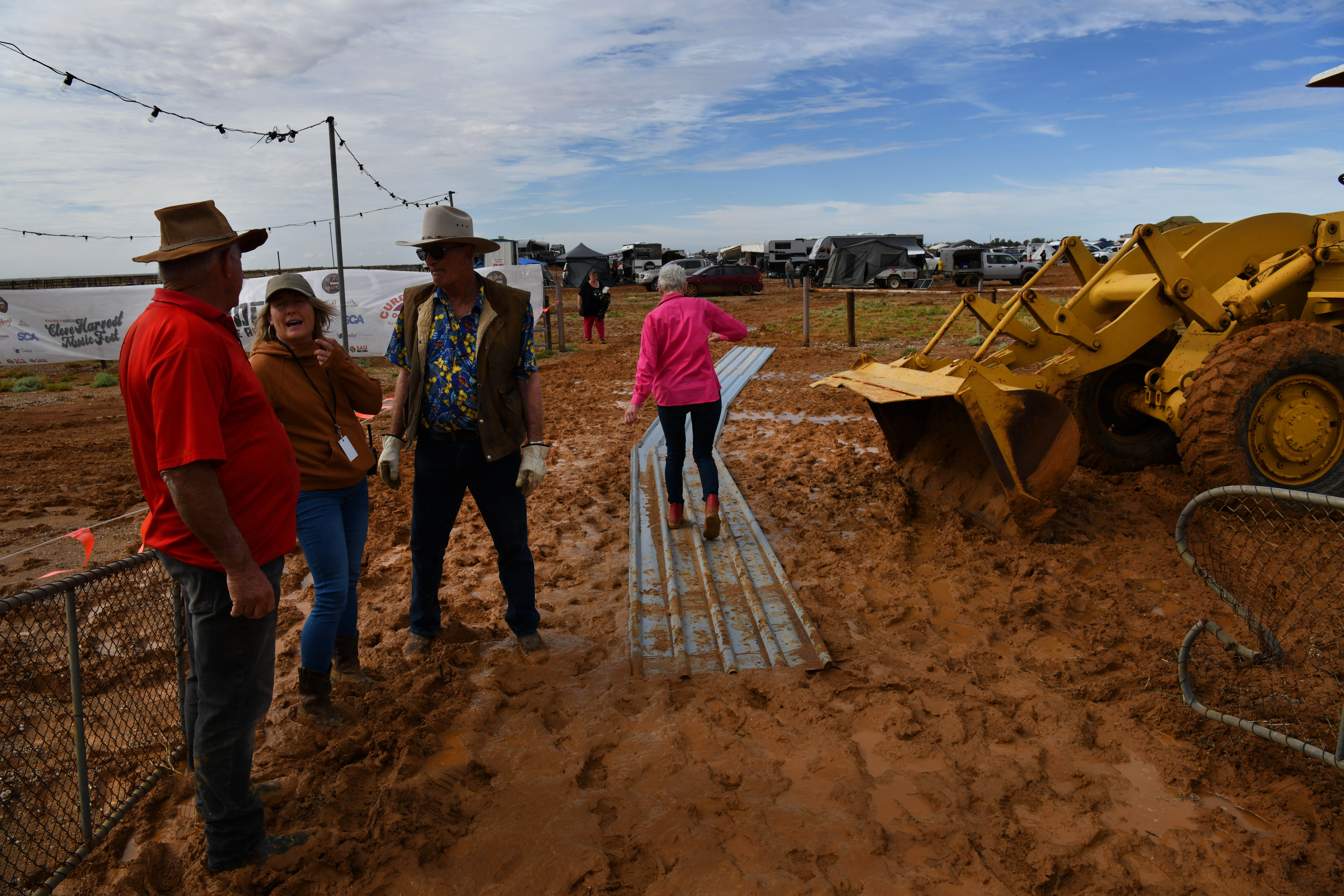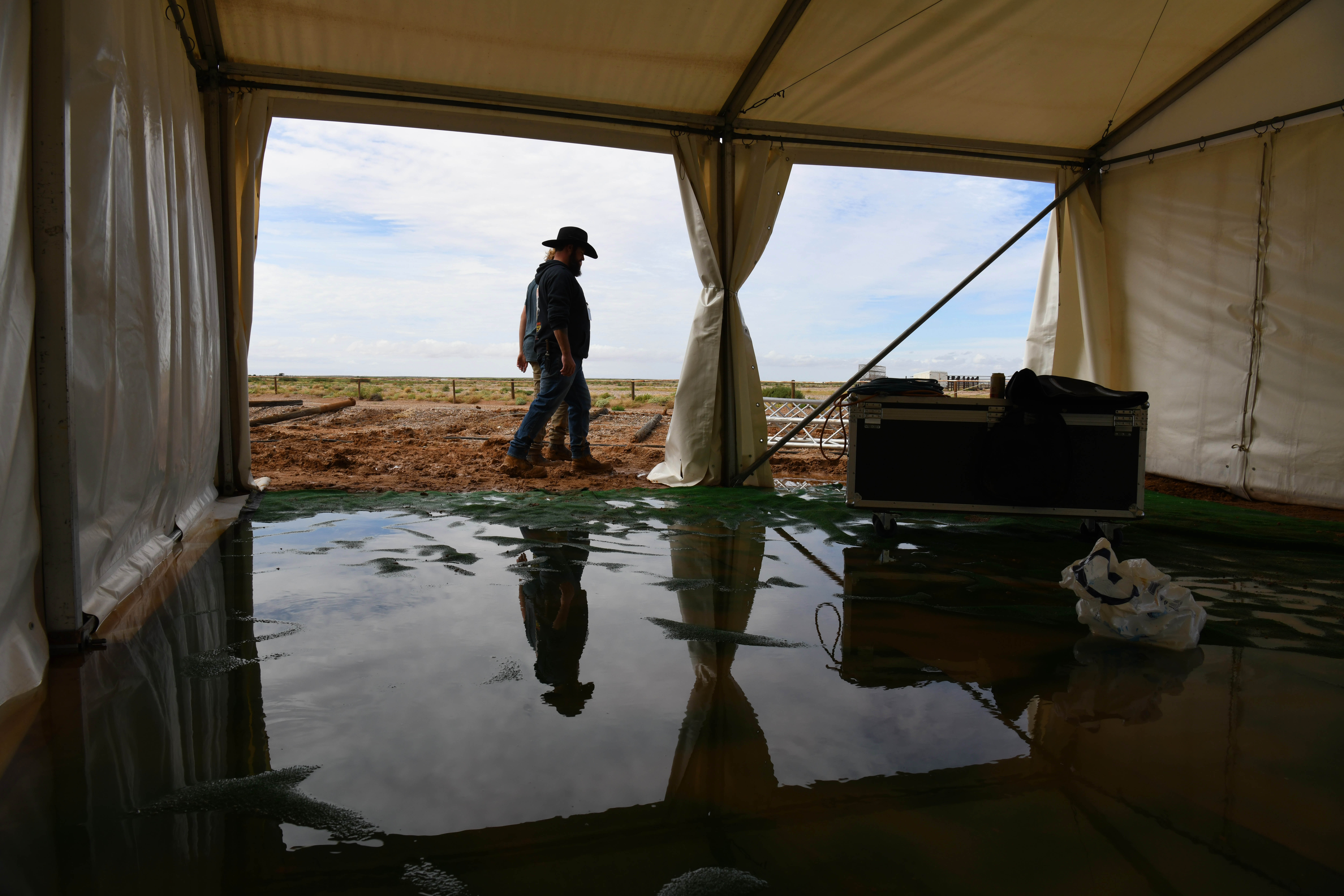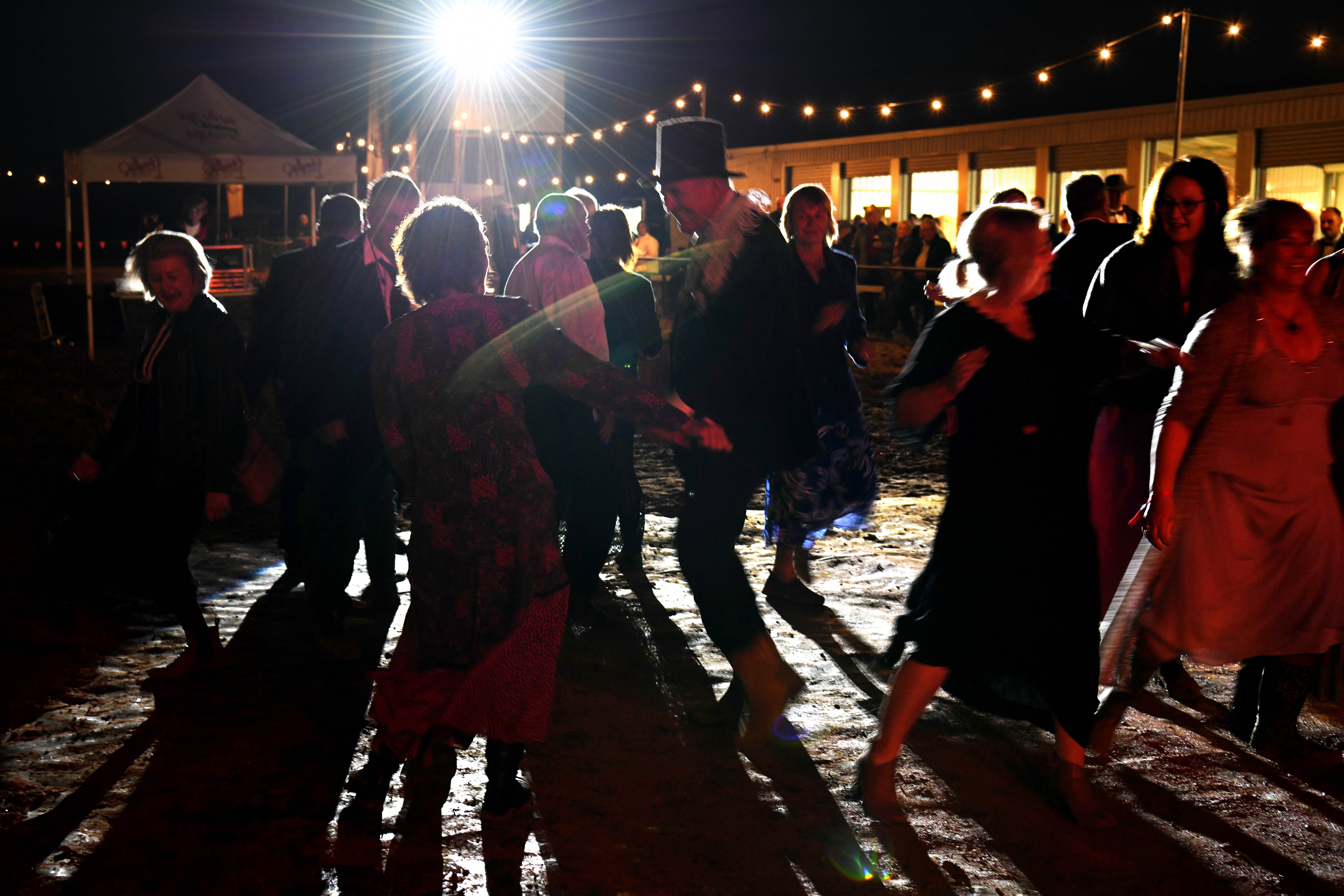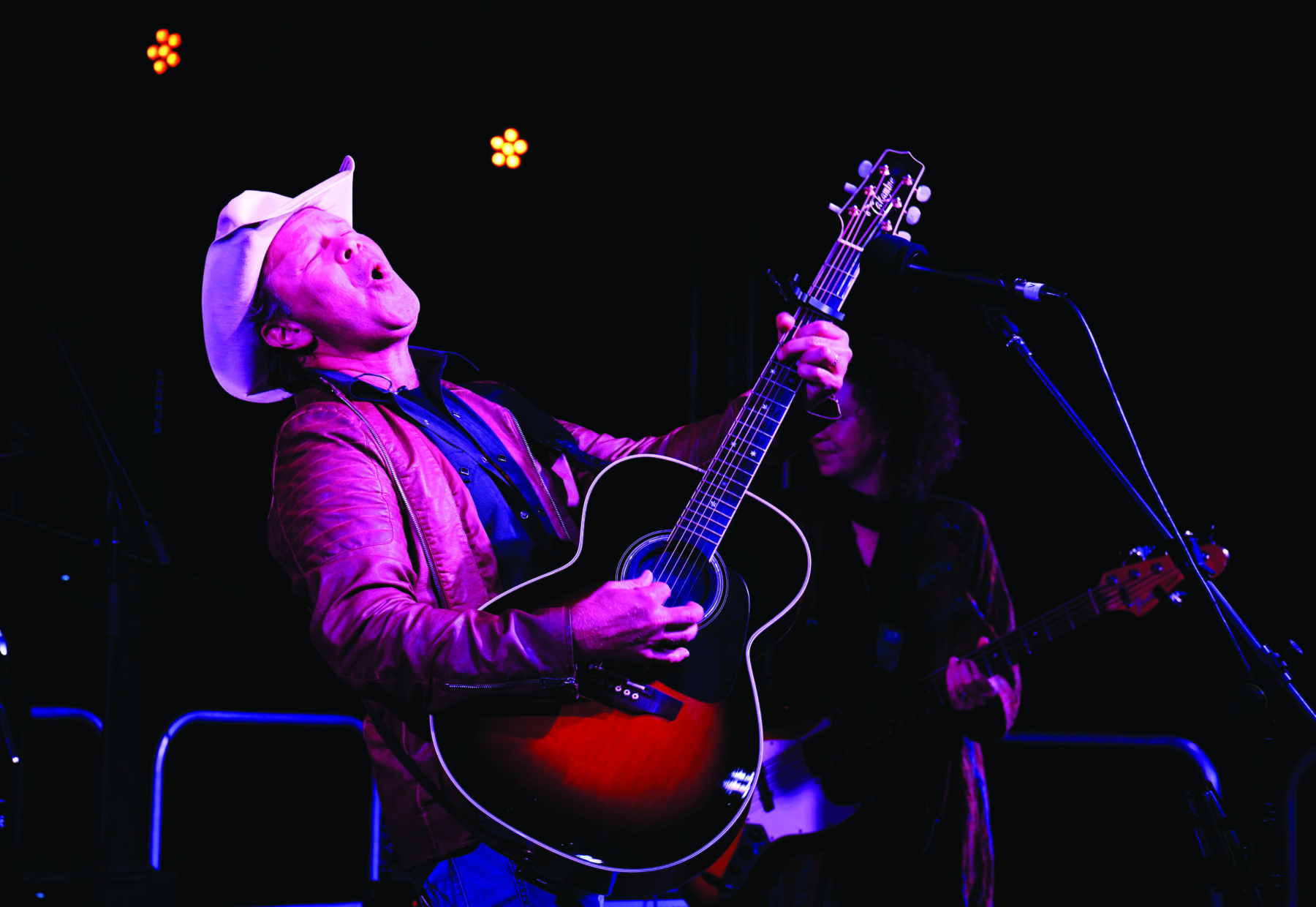Almost 600km north of Adelaide, where the famed Oodnadatta and Birdsville tracks meet, John Simpson and Renee Ormesher are frantically working their phones.
Perched on stools in the front bar of the historic Marree Hotel, they’ve set up a temporary office to coordinate the logistics of bumping in the Curdimurka Outback Ball. This once-legendary annual outback event hasn’t been held for 18 years, but it’s about to be revived.
Moves for its resurrection began one day a few years back, when John and Renee were having lunch in the Marree Roadhouse and were asked by locals: “Why don’t you start it back up again?” As collaborators in Revive the Regions with Music, a touring company supporting regional South Australia and its musicians through remote festivals, they had the credentials. And in that laconic Aussie outback way, after a drink or two, John thought, I’ll give it a shot.
So began the epic task to resurrect and reclaim what had become a largely forgotten late-20th-century Aussie institution.
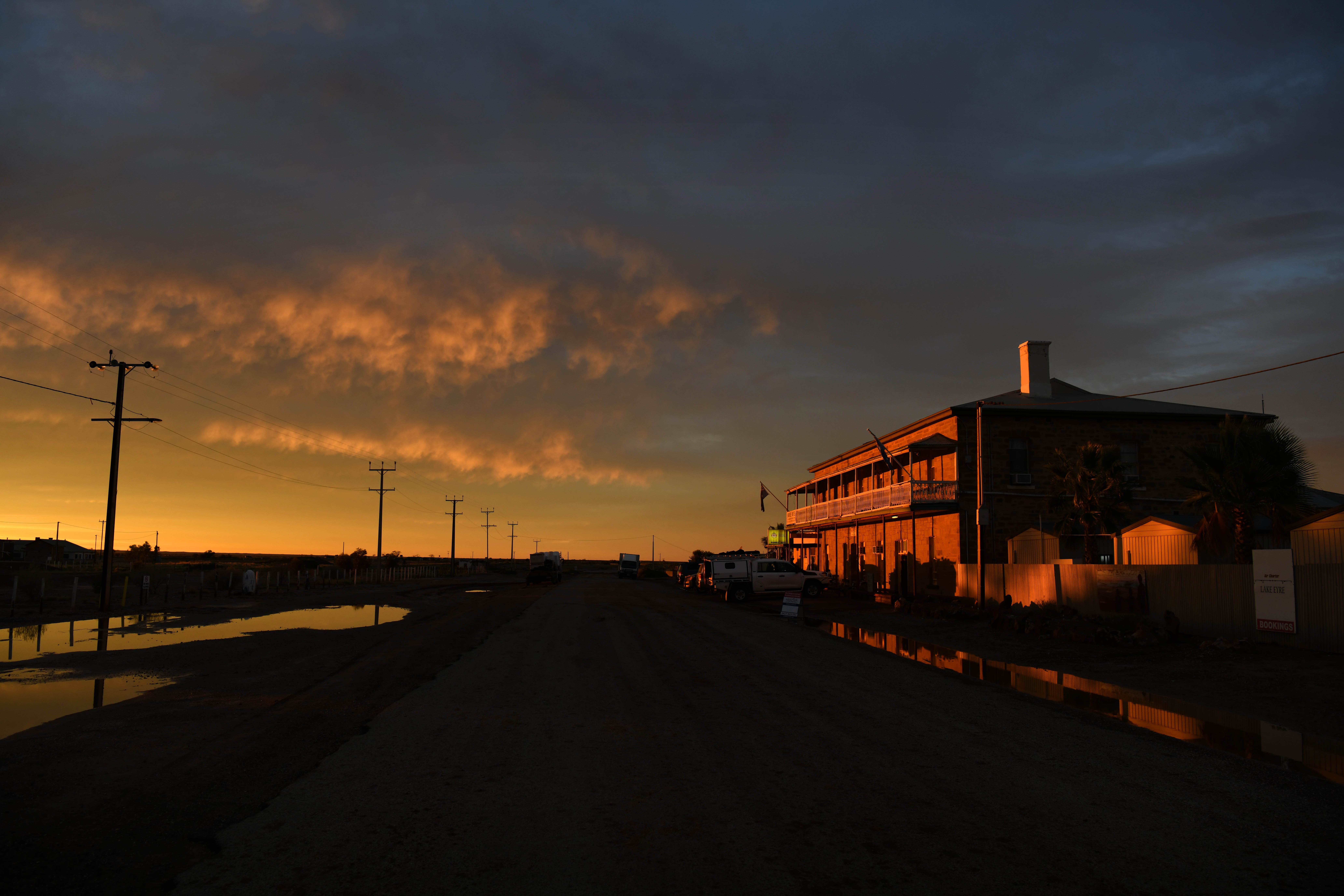
The first Curdimurka Outback Ball dates to 1981, when Simon Coxon, a survey technician with what was then the SA Department of Lands, drove past the Curdimurka railway siding while working in the Lake Eyre region.
He noticed an upturned trolley on the abandoned tracks of the former Ghan railway line, which had been closed the year before. Prompted by the state of deterioration he saw, Simon founded the Ghan Railway Preservation Society and successfully applied to have the siding listed on the SA
Heritage Register.
“I was concerned that little effort was being made to preserve anything of the old line and its heritage,” he explained simply in Outback, & having a ball! (AG 48) in 1997.
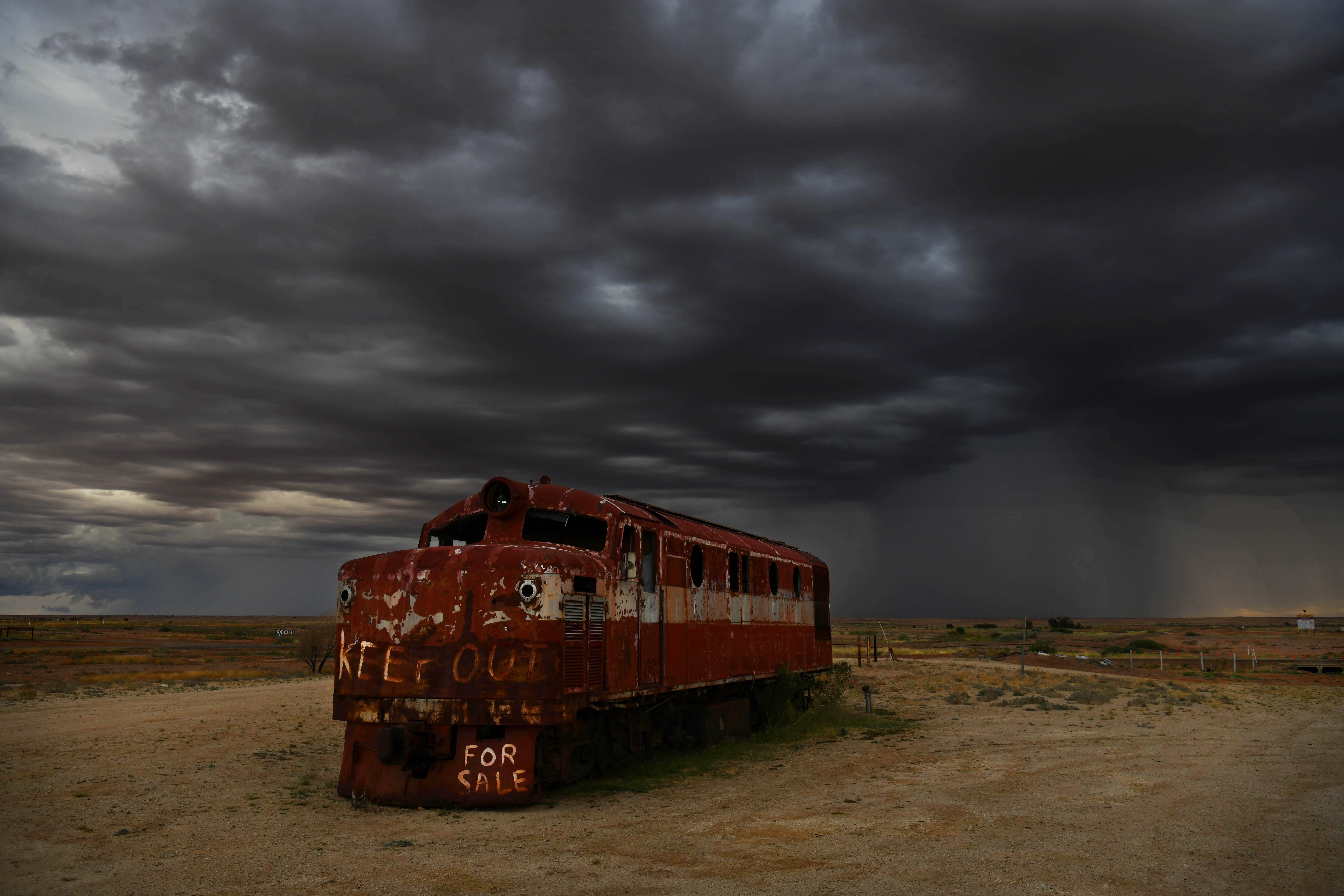
The Central Australian Railway is a 241km narrow gauge railway that was built from 1878 to 1929 between Port Augusta and Alice Springs. There are a number of stories surrounding how the railway came to be known as the Ghan soon after it opened; one of the more popular theories is that it was a tribute to the pioneering 19th-century Afghan cameleers who helped open up Australia’s interior. After construction was completed in 1980 of a standard-gauge railway linking Port Augusta and Alice Springs, some 200km to the west, the old narrow gauge Ghan line was abandoned.
Not long after his 1981 visit to the Curdimurka siding, Simon had the idea to hold an upmarket fundraising event there to support the preservation of its heritage, and, in 1986, 105 people sat down to a silver service dinner to raise money for its restoration.
Two years later, in 1988, 218 people gathered there again, this time for the Fettlers Ball. After quickly developing a reputation, that event was held again the following year. By 1990 patronage had swelled to some 1600 people and the Curdimurka Ball was born.

The 2022 rebooted version of the event, which John and Renee are organising from the front bar of the Marree Hotel, has been relocated: the days of the Curdimurka Outback Ball being hosted at the historical railway siding are long gone.
“It was BHP that killed that,” John says with a sardonic eyeroll as he mentions the big mining company that now oversees the site. “They didn’t actually say ‘no’, but the restrictions they put in place made it untenable, forcing us to look for another venue.”
John and Renee initially looked around the historic ghost town of Farina, about 50km south of Marree, before settling on a site at Clayton station, about the same distance north up the Birdsville Track. The 1600ha Clayton paddock offered as the location for the revived ball seemed ideal, its natural amphitheatre and towering dunes providing the perfect desert aesthetic.
But nature thought otherwise.
An unseasonal trough that extended from the Gulf of Carpentaria in the continent’s far north down through the Lake Eyre basin and on to Adelaide threatened enough rain to close the Birdsville Track. With a malevolent weather forecast for the date of the event, the decision was made to relocate the ball away from Clayton station.
“I initially thought of outside the pub in Marree, but in the end settled on the [town’s] racetrack,” John says. “It was the right decision. We had nowhere else to go.”
They begin rolling into Marree two days before the gates to the track are opened for the ball, and oversized and over-accessorised mobile rigs soon colonise the township’s centre. But the weather forecast has delivered on its promise, and ground crews are now working feverishly around the clock and through a quagmire to get the ball’s music stage in place on time.
It’s touch and go. Patrons have manoeuvred their rigs into pole position, staking their claims on the edge of town to capitalise on the best campsites.
But still the indicator sign at the beginning of the Oodnadatta Track is reading CLOSED and an eager queue extends back right through the centre of town.
Undeterred by their temporary holding patterns, festival- goers begin to get down to what they’ve come here for. Spontaneous cocktail parties spring to life. Lavish spreads of cheese, cured meats and antipasto delicacies are laid hastily across camp tables. And the wine starts to flow.

Inside the Marree Racetrack, 800m from the lunching roadside hordes, local Marree man Jeff Litchfield sits high in the driver’s seat of a bright yellow dozer, a donation from the Marree Hotel.
Sporting a tan, wearing a 10-gallon Akubra hat and striding about the site with a three-days-in-the-saddle gait, Jeff is one of a consortium of locals lending voluntary support to the event’s organisers. He’s busy dozing tracks through the sludge to ensure passage to the track’s interior.
Two hours before the first scheduled arrivals, Jeff is mired in multiple tasks, rescuing the festival’s already bogged generator, dragging stricken vehicles and vans from the morass, and installing portable toilets in the soon-to-be-established campsite. Marree is famous for its hard, clay-like ground surfaces, but they’ve been transformed into sludge as the forecast rain has bucketed down and it’s now challenging even the most intrepid of this gathering.
Eventually vehicles are let into the designated camping zone, and as they stream in, they slide, career, and even jack-knife while jostling to get their camping inhabitants settled before nightfall. Meanwhile, deep within the racetrack interior, the Cahoontas are already busy constructing a
Hawaiian surf club tiki bar that will become the centrepiece of this group’s four-day stay. The Cahoontas – a portmanteau of Cahoonas and Hooters – is the tribe of Tim and Vicki Kernick (see previous page).

They comprise a coalition of decorated SA surf lifesavers and Country Fire Service members and this is not their first time together in the remote Australian desert. They’re well versed in how to party with style, no matter the conditions.
When news of the return of the Curdimurka Ball began filtering out, the Kernicks’ interest was piqued. “We were on a Simpson Desert trip with our crew in 2021 when our good friend Paul Victory informed us and immediately we thought, This is OUR ball!” Tim says.
After returning to Adelaide, Tim began scrambling together artwork for commemorative, personalised stubby holders, adorned with the Cahoontas couples’ monikers laid over a Simpson Desert sunrise – The Toolman (Tim) and Voluptuous (Vicki), Croc and Super Sally, and Wild Horse and Tumbleweed. “You have to do this stuff,” Tim says, “because sometimes things get a little loose and you need to know whose drink is whose.”
Flanked by an ever-sprawling convergence, the Cahoontas already have several camp ovens on the go.
The aromas of roast beef and rosemary-infused lamb shanks rise in the crepuscular light and coalesce with the smoke from myriad fires illuminating the landscape. Some have been fuelled by the Ghan’s historic railway sleepers, which were laid more than 100 years ago then ripped up after the track between Marree and Lyndhurst was discontinued in the early 1980s.
As night falls, camp ovens everywhere spit and sizzle in the constant rain and late arrivals struggle haplessly to manoeuvre onto dry ground. Among these unfortunates are Andrew and Danielle Eglinton from Adelaide, whose camper trailer becomes stuck fast in the wretched sludge. But there’s no shortage of good Samaritans here. Strangers emerge from the dark with tow ropes and four-wheel-drives magically appear. And someone trudges off into the night in search of “that big fella with the dozer”.
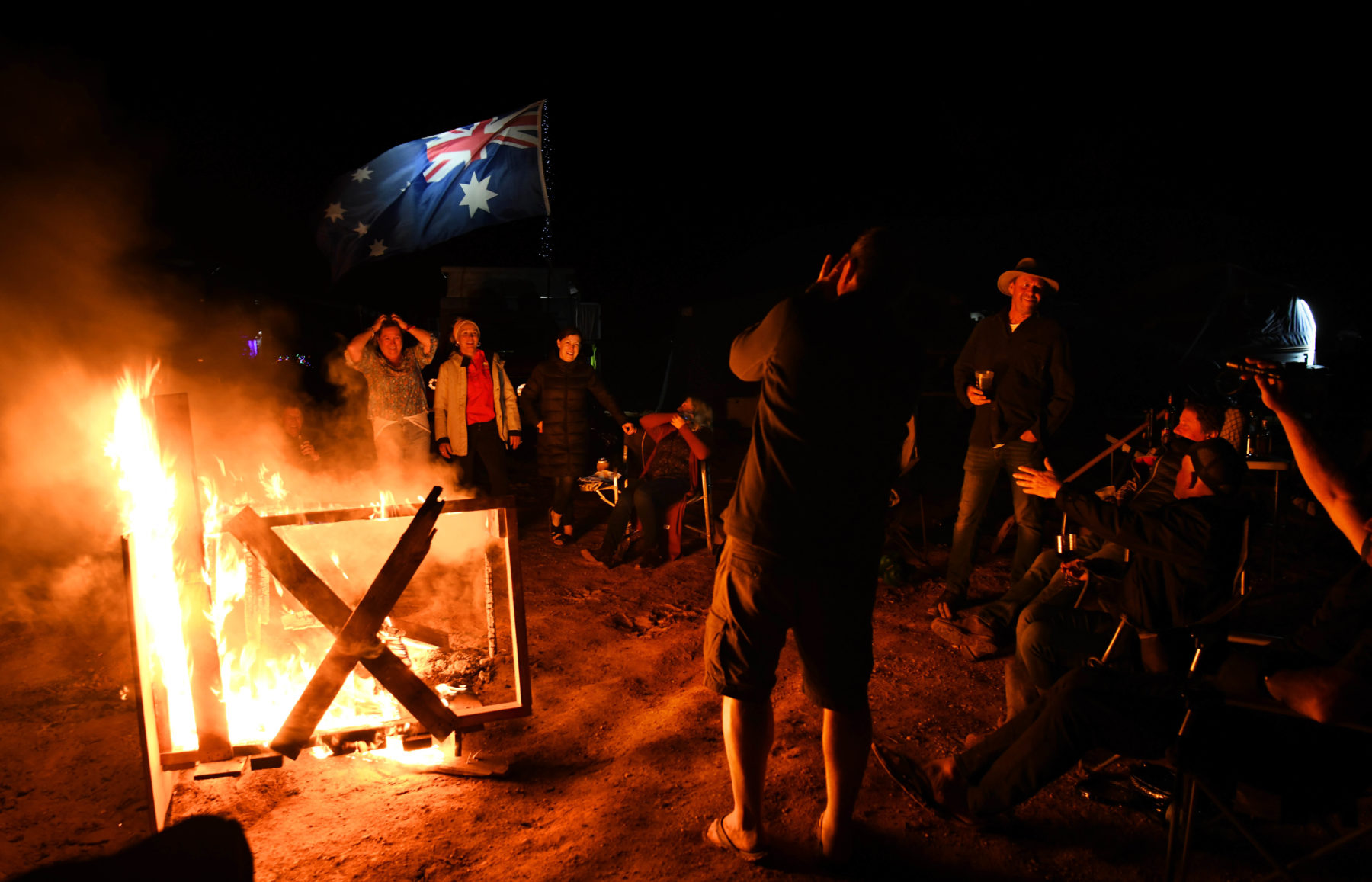
“Getting bogged is a spectator sport!” quips a member of Camp Cahoonta. “It’s all good and fun until it happens to you.” The Cahoontas’ site is now defined by an oversized Australian flag fluttering steadily under a cool westerly that’s being driven by the passing cold front.
Next morning, it’s a grey, sodden dawn that greets the campers. Those valiant enough to keep up their usual morning constitutional find themselves ankle deep in mud after the night’s rain. A few are in thongs; others have forsaken shoes altogether and some require rescuing from marooning.
On the evening of the ball, they emerge from the darkness and the mud. Aided by the guiding light of a single strand of tungsten globes, they traverse the ruts and trenches that now make them a captive audience. And most of them are decked out in all the finery and cheer of the ball’s previous black-tie dress expectations.
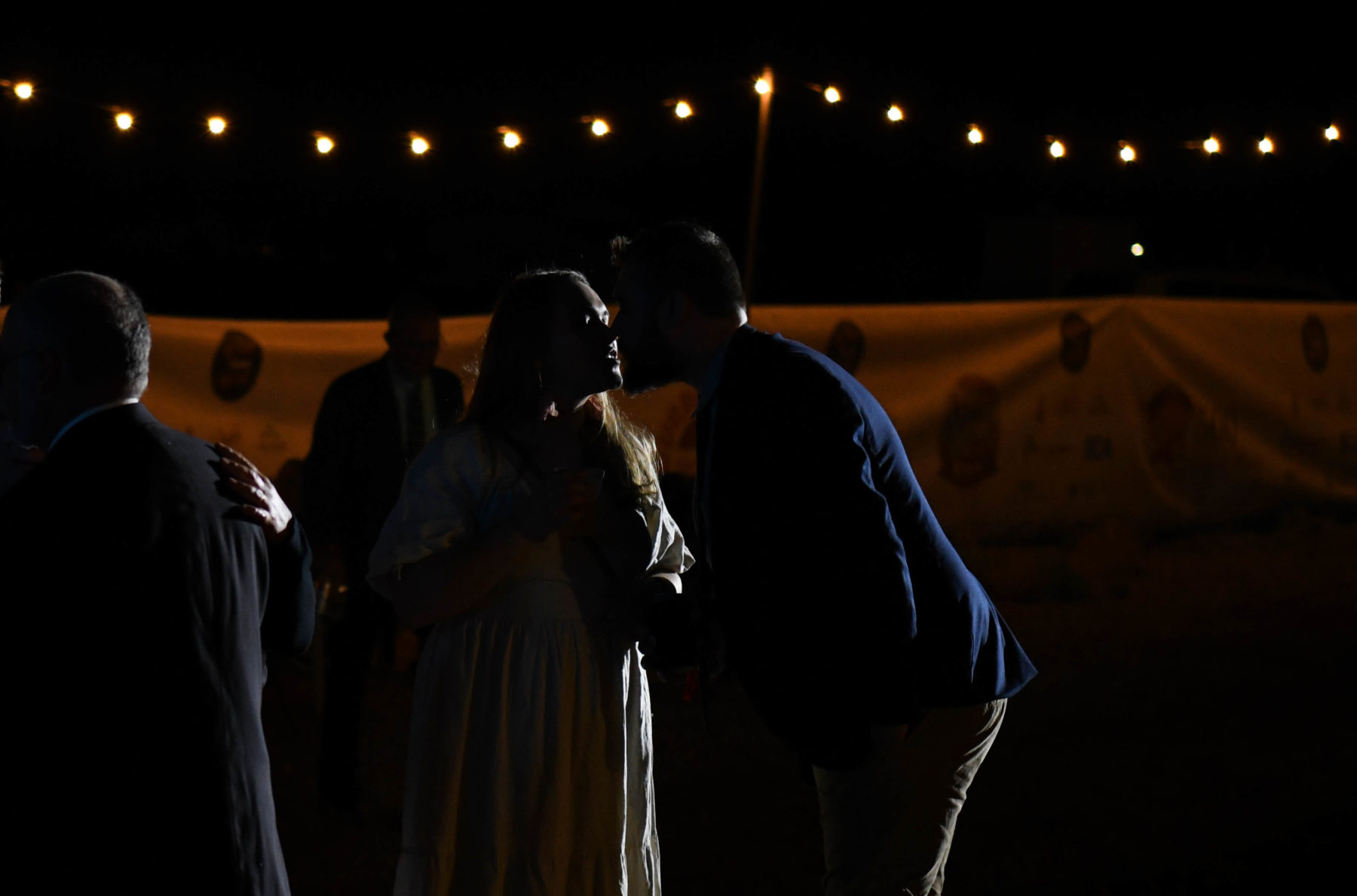
Tails and top hats, boas and silk, they shuffle in harmony and grace across corrugated iron sheets laid hastily across the track to preserve, mostly, the dignity of patrons. “Oh, you are just like our husbands! You want to see us fall face down in the mud,” I’m jokingly admonished by a company of women dressed in ball gowns and Blundstones; I’m trying to photograph them as they negotiate a passage onto the last furlong of the heavily steeped Marree Racetrack, the designated dance zone.
There’s a stunning line-up of pre- and post-ball entertainment offered up by the likes of Reg Dodd, the Cherry Pickers, Matt Cornell, Michaela Jenke, Caitlin Drew and the Viper Creek Band. Greeting the steady flow of arrivals on stage are the Nabiac-based duet of Brooke McClymont and Adam Eckersley. These multi-award-winning country singer-songwriters and ball favourites are among Australia’s finest country musicians.
Meanwhile, warming up the dance floor are bootscootin’ aficionados Claire Harris and Kate Strong. Formerly a stock report journalist and agricultural consultant respectively, the pair threw away their jobs earlier this year to traipse around the country promoting the virtues of linedancing in support of several rural charities.
The charm and elegance of theatrical stars Rachael Beck and David Hobson helps entice the crowd onto the dance floor, where for two long hours they swirl and dip in sequins and gumboots, ostrich feathers and vintage rabbit-fur coats. A polished repertoire of cabaret entertainment envelops the dancers under a vast blanket of cool desert stars. “Welcome to the Royal Marree Opera House!” David bellows down the straight as the dance floor erupts amid an enchanted cacophony.
But the night really belongs to one man whom everyone is here to see – the legendary Troy Cassar-Daley. With some 40 Golden Guitars and many other music awards under his belt and more than three decades of treading the boards, Troy is one of the nation’s most celebrated mainstream country music artists. Among this mob he’s king and on this night doesn’t disappoint as he segues from centuries-old traditional folksongs into a blistering country music hootenanny within the space of a few chords.
As the night draws to a close, a migration begins towards the still-smouldering campsite of fires and sludge. But at Camp Cahoonta the party is just getting started. A burgeoning tradition among this tribe of desert farers is about to begin – the burning of the bar – literally. With a concerted effort, the Cahoonta Bay Surf Club tiki bar is hoisted upon dying embers, igniting a bonfire that draws neighbouring campers to rejoice the end of a spectacular ball.
Ripping the synthetic grass from the partially submerged entertainers’ green room, laid waste by the previous day’s rain, organisers John and Renee are already mired in thoughts of how to make their next venture work, and how they’ll extract themselves from the financial hole this ball has left them in. “Everyone had a fantastic time,” Renee enthuses. “The artists loved it and the patrons loved it. The greatest reward is seeing people and artists connect, and, most importantly, having a great time.”
John, however, is less rosy about the ball’s outcome. “If it was a success, we’d actually make some money,” he says, as he elaborates on the reason for his dejected mood. “It’s terrible – we’re now facing losses in the tens of thousands of dollars. I just need to work out how to get it back.”
With heavy eyes, Renee looks out at the track from the confines of the huge, corrugated iron racetrack shed, watching as the stage is slowly and meticulously dismantled. “It’s bittersweet,” she agrees. “We’ll go home and cry a little bit, but it’s been a beautiful little disaster.”
An Outback love story
When Vicki Langley finished a hairdressing course at Adelaide TAFE in 1986, she headed overseas with friends and landed a hairdressing job in London. On her return to Adelaide in the spring of 1987, she naturally fell back into the company of Tim Kernick, with whom she’d become acquainted before her departure.
“I knew Tim previously through overlapping social circles,” Vicki reminisces as she stands in the sodden interior of Marree Racetrack, recalling the couple’s tentative teenage mutual attraction.
But in early 1988 Tim left Adelaide for a round-Australia trip. “I jumped into my old Pontiac, threw in the microwave and bike and was off,” he recalls. By mid-year he was based in Alice Springs, more than 1300km from Adelaide, working as a mechanic, but he would sometimes return to Adelaide to catch up with friends and family.
“We ran into each other one night at a Christmas party or something like that,” Vicki says, recalling that at the end of the night she was given a lift home by Tim. Love blossomed, and as Tim left to return to Alice Springs, Vicki promised herself she’d get a job on the Ghan in the hope they could meet up again. She became employed in the train’s “entertainment carriage”, which had a hairdressing salon as well as poker and video game machines and a tiny souvenir kiosk.
(Right) Dressed in their finery, Tim and Vicki join fellow Cahoontas and other ball patrons to dance the night away under the desert sky at this year’s event.
In the autumn of 1988, Vicki and Tim embarked on a three-year romance that became forged into a lifelong union along the tracks of Australia’s most famous railway journey. Vicki began working regularly on the Ghan’s Adelaide to Alice Springs section during the April–October season and would call in regularly to see Tim.
When the Ghan’s entertainment carriage was closed in 1991, Vicki’s position ended. But Tim joined her as she caught her last ride back to Adelaide out of Alice. “He packed up all his worldly possessions and we stuffed the entertainment carriage with his belongings,” Vicki says. “The boss definitely didn’t like that!”
In 1993 the pair married and in 1994 looked for a unique experience to celebrate their first wedding anniversary. They saw an ad promoting the Curdimurka Outback Ball. “We were both really familiar by then with the Ghan, its history and the environment. We loved the remoteness of the desert too,” Vicki says. “We’d read about the Curdimurka Ball and decided that was the place we’d go.”
And so, after cobbling together a tight-knit group of friends, the Kernicks made their first wedding anniversary a pilgrimage into the heart of SA’s remote interior, to a black-tie ball that, throughout the 1990s, developed into one of Australia’s seminal outback events.


